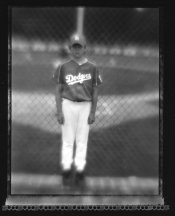At one time or another I've owned a Busch model D, a Meridian, a Micro-Precision, a Burke & James, and many variations of Speed Graphic. The Meridian and the Micro-Precision were the poor man's Linhof with the back movements valued by scenic photographers. The former, like the Busch and late SG, used proprietary lens boards while the B&J, M-P, and older SGs used easily fabricated and readily available boards. As mentioned in an earlier post, the Busch had the smallest lens board which would preclude the mounting of monster lenses. None of these cameras had focal plane shutters except some models of the SG. Only some models of the SG were fitted with the versatile Graflok back, although I've seen Graflok backs grafted onto other models and brands. The SG system was extensive. The Graphic Graflex Photography manual available in many editions over many years is a valuable resource. Early editions included articles by icons of the era such as Ansel Adams, Barbra Morgan, Rudolf Kingslake, and Laura Gilpin. SG still used well-crafted leather covered wood bodies while the others were all metal. However, this served them (and us) well. The SG accepted a range of focal lengths more conveniently than the others with its fold-down infinity stops and, in the later models, interchangeable rangefinder cams. Perhaps the biggest shortcomings of most SGs were the lack of a revolving back and the limited (or nonexistent) front tilt. The modest B&J had both of these, but may have had poorer build quality. Any of these cameras (and the expensive Linhof) in good condition and with appropriate lenses would serve the OP well. A Crown Graphic without the rangefinder and the tubular viewfinder is probably the lightest and most compact.



